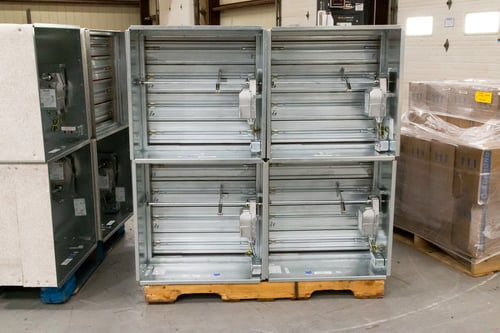Dampers can be connected into larger assemblies. In this article, we discuss how dampers go together and a few ways to synchronize their blade rotation.
Dampers are usually built as a single panel that fits inside a duct, but there will be times when you need a larger damper. Every damper has a maximum single panel size. Let's say the damper’s maximum width won’t cover the necessary space for the opening.
In situations like this, you would need at least two dampers to fill the opening. This is possible with a multi-damper assembly.
.png?width=500&height=298&name=MCDLG%20Blog%20Images%20-%20Multi-Panel%202x1%20Horizontal%20(resize).png)
Damper panels can be connected horizontally and vertically to meet the necessary size of the application. Horizontal connections join the jambs of each damper so that they sit side by side when fully assembled.
Space is provided for in-jamb linkage so that the connected dampers can operate. In this state, the dampers will operate independently of each other. You would need to install a jackshaft to synchronize them. We will discuss jackshafts later in this article.
Vertical connections set one damper on top of the other, so that the sill of one damper is connected to the head of the damper below it. These connections will typically sit flat since there is no linkage in these areas. Dampers with vertical blades will have space for the linkage along the vertical mullions.
.png?width=307&height=550&name=MCDLG%20Blog%20Images%20-%20Multi-Panel%202x1%20Verticle%20(resize).png)
Multi-panel assemblies require additional support to hold the damper in place. The type and number of supports will depend on several factors, including the assembly’s total size and the maximum static pressure of the application. Manufacturers will provide details on the necessary support in their installation instructions.
Each connected panel will be a standalone damper with its own set of linkage. The damper assembly will need the means to open and close blades across all panels. There are ways to establish synchronous opening and closing actions, but it depends on where the damper is in the assembly. Horizontally connected panels can be tied together with a jackshaft, so that they all open on the same action.

A jackshaft is a metal rod installed across the back of connected dampers. The jackshaft will be attached with bearing brackets to the driving blade of each damper to synchronize their blade action. When the leading damper turns its blades, the jackshaft will translate that rotation to all horizontally connected dampers.
Vertical jumper linkage is an on-face assembly that connects the driving blades of vertically connected dampers. A vertical jumper will translate the rotation of the bottom damper’s blades to the blades of the top damper. Think of it like an on-face linkage that goes between two dampers: when the bottom damper opens, the blades of the top damper will be moved to open as well.
With jackshafts and vertical jumper linkages, a multi-panel damper assembly can open all blades at once.
.jpg?width=500&height=404&name=Steel%20Damper%20-%20496%20-%20Multipanel%20with%20Jackshaft%20(Resize).jpg)
Note the metal bar that runs across the two dampers. This is a jackshaft.
Two horizontally connected dampers can be tied to a single actuator, so that they rotate their blades at the same time. The actuator will need to provide the necessary torque to rotate both sets of blades. These two dampers can also receive separate actuators so that they can open and close at separate times.
This can be a viable option for zoning and mixing applications. For larger assemblies, such as three or more panels across, you will need to establish primary and secondary actuators for each panel.
The primary actuator will dictate the blade action for all connected dampers. Secondary actuators will be wired to the primary actuator to mirror its actions. These actuators provide the necessary torque to fully rotate all blades in the assembly.
For vertically connected dampers, the primary actuator will be tied to the bottom damper. The top damper will have a secondary actuator and a position indication switch to help determine the position of the blades. Learn more about position indication switches here. Secondary actuators follow the actions of the primary actuator.
Manufacturers will specify which dampers in the assembly need actuators, and whether each actuator will be a primary or secondary actuator. Consult with the manufacturer for your specific configuration.
.png?width=400&height=409&name=MCDLG%20Blog%20Images%20-%20Multi-Panel%202x2%20(resize).png)
Multi-panel damper assemblies provide the benefits of a single panel control damper for applications with lots of space to fill. You have options for these applications. If you have need for dampers for a large space, then consider connecting them together into a multi-panel assembly.
For more on dampers, check out these Newsstand articles:
- Anatomy of a Damper
- The Condenser - A Closer Look at Linkage
- Air Performance and Control Dampers
- Understanding Your Dampers
Need help with a current project? MCDLG is here to help. We have over 50 years in the HVAC industry, building louvers and dampers for all sorts of applications. Contact us online and let us answer your questions. Let us put our experience to work for you.
.webp?width=91&height=70&name=MCDLG%20Logo%20(Resize).webp)
.webp)




